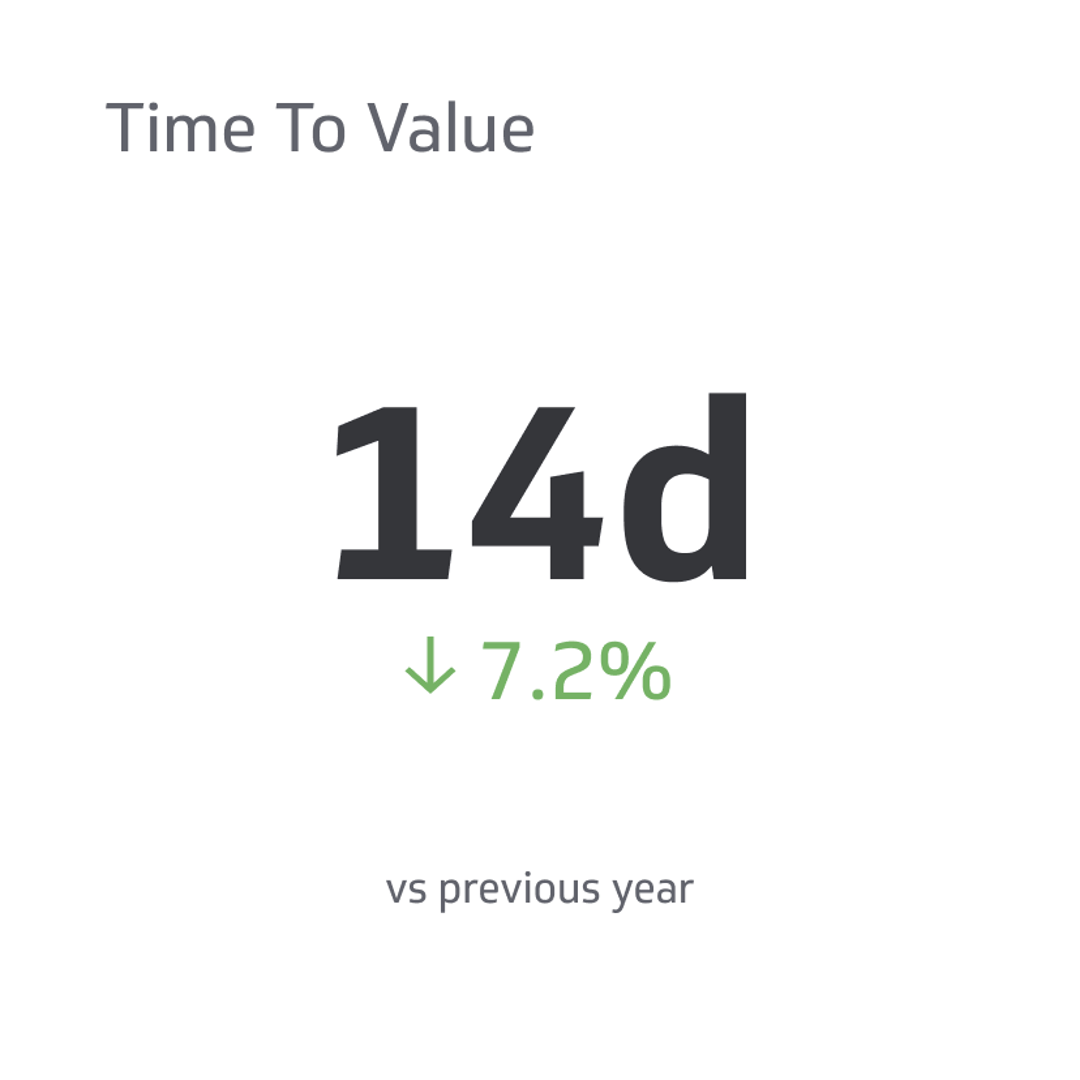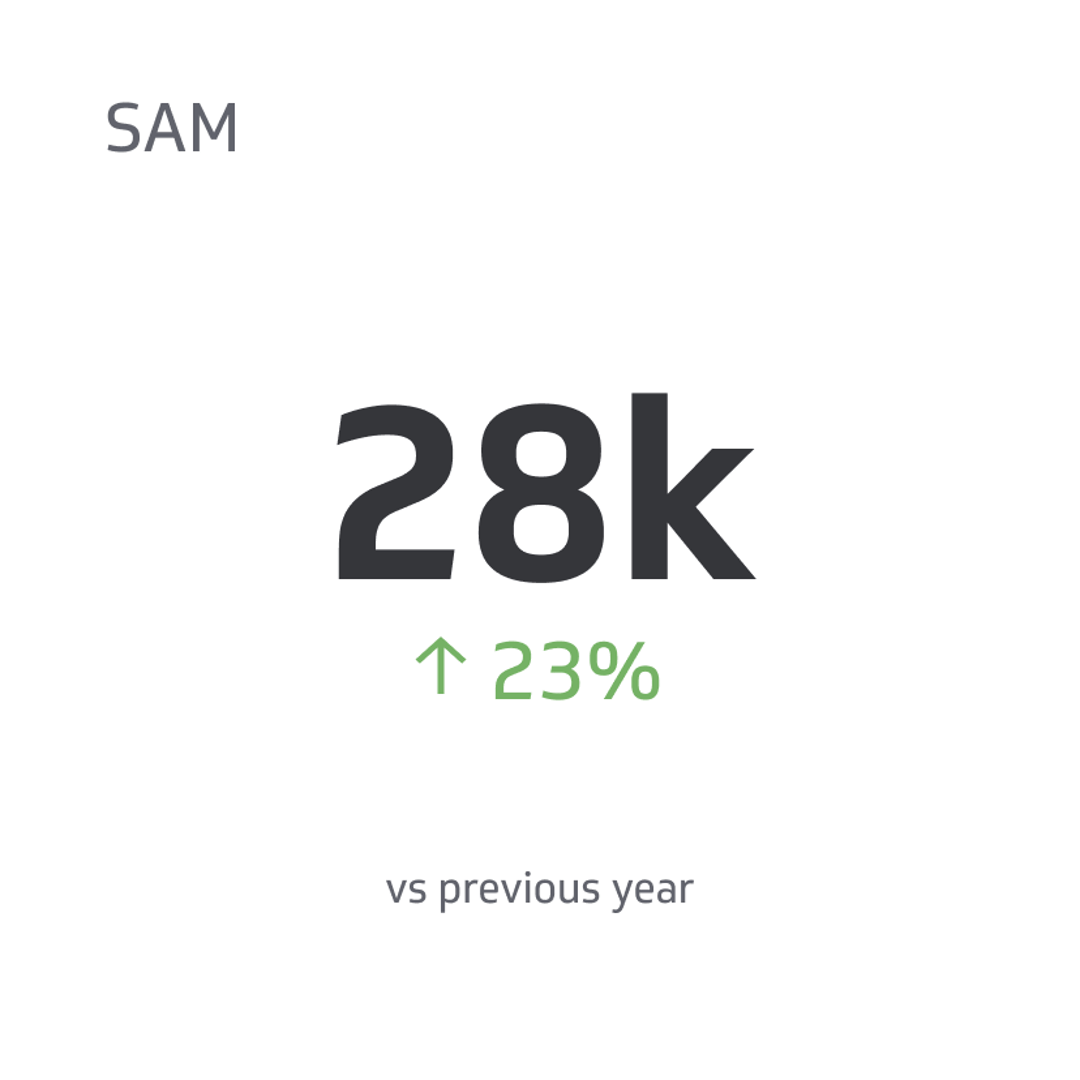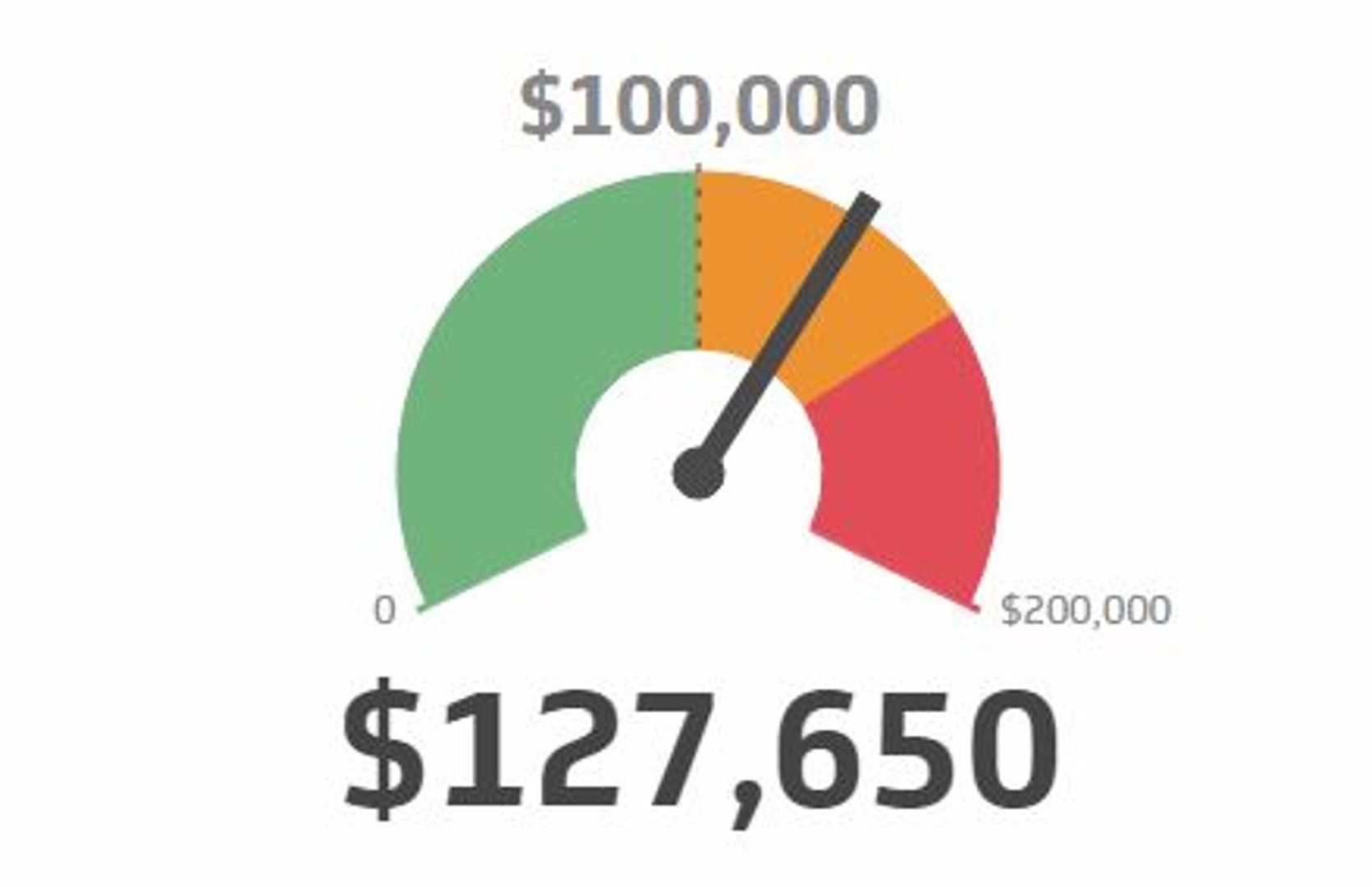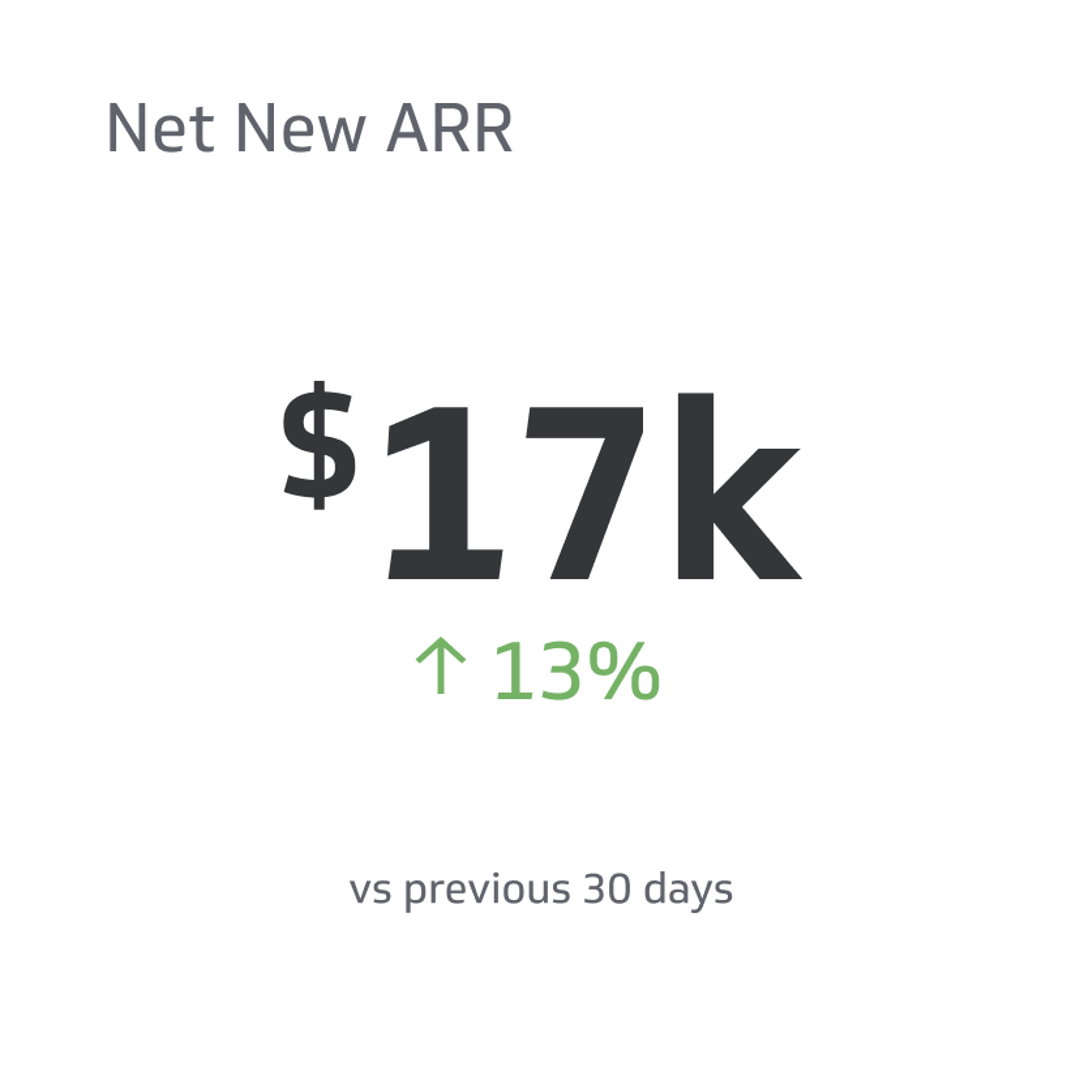Time to Value (TTV)
TTV, or Time to Value, is a metric used to determine the amount of time it takes for a customer to see the value of a product or service.
Track all your SaaS KPIs in one place
Sign up for free and start making decisions for your business with confidence.

TTV, or Time to Value, is a metric used to determine the amount of time it takes for a customer to see the value of a product or service. This metric is vital for all types of businesses, especially those in marketing, operations, analysis, and SaaS.
By measuring TTV, you can understand how long it takes for your customers to see the value of your offerings and make adjustments to your processes and strategies accordingly. This helps increase revenue, improve customer satisfaction, and optimize business processes.
In this article, we’ll explore TTV in detail and explain why it's an essential metric for your business. So, let's get started!
Why TTV Matters
If you're looking for a metric to measure how quickly your customers engage with your product or service, TTV might just be the answer. This metric is useful for improving your marketing efforts.
Additionally, it's affected by factors such as the complexity of your offerings, the quality of customer support, and the overall customer experience. By measuring TTV, you can identify areas that need improvement and make changes to decrease the time it takes for customers to realize the value of your offering.
Engage Clients
Measuring Time to Value (TTV) is a great way to increase and maintain customer engagement. When clients quickly realize the value of your product or service, they're more likely to become loyal customers.
On the other hand, clients with low TTV may become disinterested and distracted, causing you to lose potential business. This is why it's essential to have engaging marketing strategies that capture the attention of your audience.
If customers don't realize the value of your offerings quickly, it may be a sign that there's something wrong with your product or your onboarding process. To prevent this, work on decreasing your TTV by making it easier for customers to use your product or service and providing excellent customer support.
Gain An Edge Over Competitors
Measuring Time to Value (TTV) can give businesses an advantage over their competitors in several ways. Firstly, it helps identify areas where you can improve the customer experience, leading to higher customer satisfaction, loyalty, and repeat business.
Plus, you can also identify opportunities to upsell and cross-sell products and services, leading to increased revenue. This is because customers who quickly see the value of your products or services are more likely to invest in additional offerings.
Furthermore, TTV can help businesses to identify customers who may be at risk of leaving for another company. By recognizing these at-risk customers, you can offer them discounts or additional support, which may persuade them to stay with your business.
Identify Potential Problems
Measuring TTV can help businesses identify potential issues affecting their customer experience. Tracking the average TTV for different customer segments can reveal areas where marketing or onboarding processes need improvement.
For instance, if the TTV for new customers is lower than the average, it may indicate a problem with the onboarding process. In this case, providing more training or support for new customers can help improve the process and increase TTV.
Improve Customer Retention
Measuring TTV can help improve your customer retention rates. If your customers realize the value of your product or service quickly, they are more likely to remain loyal to your company. Plus, peeping track of TTV can help you understand how to increase customer satisfaction by demonstrating the benefits of your service and why customers should continue to use it.
Increase Sales
By tracking TTV, you can increase sales and facilitate company growth. Customers who quickly understand the value of your product are more likely to recommend it to others, leading to increased sales. Plus, this can help your business to build a positive reputation and stand out in a crowded marketplace.
Set goals
By measuring TTV, businesses can set realistic goals and expectations for customer acquisition and retention, allowing for a more effective allocation of marketing resources. It also provides insights into areas that require focus and helps direct your attention to the right places.
Types of TTV
It's important to understand the various types of TTV that can effectively market a product and benefit your business. Keep reading to learn more about them.
Immediate Time to Value (ITTV)
Immediate Time to Value (ITTV) occurs when customers experience an instant investment in the product. Although not all products can have ITTV, it can benefit your business if you have it. For instance, when a customer views a menu at a restaurant, they instantly understand the value of the menu items offered.
Products that can utilize ITTV are generally easy to advertise since the customer's observation or action has an immediate reward, and it doesn't take much for them to get invested.
Time to Exceed Value (TTEV)
TTEV, or Time to Exceed Value, is a SaaS metric that measures the time it takes for a product or service to exceed a customer's expectations. While TTEV is similar to TTV, it goes one step further by assessing how long it takes for customers to realize the full value of the product or service.
Measuring TTEV is crucial because it helps businesses convince customers to return for more. While a good TTV can initially engage customers, it's important to exceed their expectations to keep them loyal.
Long Time to Value (LTTV)
A long time to value (LTTV) occurs when it takes customers a while to realize the benefits of a product or service. This can be due to various factors, such as the product's complexity, the customer's needs, or the level of support the business provides.
It's worth noting that LTTV isn't always negative. Some purchases require more consideration and time, and customers may prefer not to rush into significant decisions, such as investments.
However, a shorter TTV is preferred in certain industries like SaaS or other sales sectors. If customers don't see benefits quickly, they may lose interest and decide to leave. Therefore, it's essential to engage customers quickly and minimize LTTV.
Time to Basic Value (TTBV)
Time to Basic Value (TTBV) is a more specific version of TTV that focuses on how long it takes a customer to receive the specific value they anticipated from a product or service.
Unlike TTV, TTBV does not directly consider the actual value of the product. Instead, it measures the time it takes for the customer to gain what they were expecting. This measurement may be helpful for marketers and analysts who want to manage customers' expectations.
Short Time to Value (STTV)
Short time to value (STTV) refers to the brief duration between customer engagement and purchasing. This term is often referred to as the "sweet spot" in TTV since it is easier to achieve than ITTV, but it does not have the disadvantages of LTTV.
For most products and services, aiming for STTV is ideal since customers can see the value of your business early on, reducing the likelihood of them switching to another company.
How To Calculate Time To Value
Now that you know what TTV is and why it's important, read on to discover how to calculate the TTV for your business.
Measure the Time to Purchase
Measuring the Time to Purchase is essential in determining TTV because it allows businesses to understand how long it takes customers to utilize their product and see its value.
Time to Purchase is the duration between a customer first learning about a product or service and buying it. By tracking this data, your business can identify areas where you can enhance its customer onboarding process and make it more user-friendly for customers to get started with your products.
Measure Time to Upgrade
Another way to calculate TTV is to measure the time it takes for new customers to upgrade to new features, such as a premium plan or additional services. However, the usefulness of TTV doesn't end when you gain a customer. You also want your customer to keep returning for more.
For example, if you find that customers are taking a long time to upgrade to a paid plan, you may need to explain the benefits of the paid subscription more clearly or offer more incentives to upgrade.
How To Decrease Your TTV
Reducing Time to Value is a top priority for businesses. As an analyst or marketer, you may be interested in improving these metrics. To achieve this goal, here's what you can do to implement these changes in your business:
Identify the Type of TTV for Your Business
As we've discussed, there are different types of Time to Value, and the kind of TTV you use to analyze your business can vary widely based on your specific industry and customer needs.
For example, if your onboarding process relies heavily on advertising, you might consider TTBV, which focuses on customer expectations. On the other hand, if you work in SaaS and want to make sales quick and straightforward, STTV or ITTV may be more appropriate.
Alternatively, if you have more complex products, you may expect your customers to take their time getting on board, and in this case, measuring LTTV may be the way to go.
Keep Advertisements Straightforward
To decrease your TTV, it's best to make your product or service easy to understand. If you're selling an online service like software, focus on writing readable product descriptions and keeping your advertisements simple.
Solving potential customer problems ahead of time and addressing any questions in your advertisements can also be helpful. By showcasing how your service can fix their problems, customers will be more excited to jump on board.
Remember to avoid lengthy advertisements or text-heavy promotional material that may overwhelm customers. Keeping your marketing materials simple yet effective is key to decreasing your TTV.
Ensure Your Product is Easy To Use
Making your product easy to use is crucial to decreasing TTV and improving customer satisfaction. Customers are attracted to easy-to-use products and may take longer to onboard with complex or hard-to-use ones.
Remember, simplicity is key to reducing TTV, so it's advisable to keep your products and services basic whenever possible. Doing so can also increase the speed at which your products sell, shortening your TTV.
Ensure Your Onboarding Process is Straightforward
If you want to decrease your Time to Value (TTV) and retain customers, offering a straightforward onboarding process is best. Be transparent with your customers about what they can expect during onboarding.
A complicated onboarding process can result in customer frustration and a longer TTV. For instance, when it comes to software programs, avoid lengthy tutorials or sessions with too many preliminaries. Instead, try using visual content or providing self-service options such as an FAQ section to simplify the process.
Set Clear Expectations With Your Customers
As a business owner, you don't want potential customers to hesitate or feel uncertain about your product or service. This is because it increases your TTV or Time to Value.
To avoid this, providing a clear and comprehensive description of what your product or service entails is essential. Customers want to know precisely what they are investing in, so you must provide all the necessary details.
Avoid being vague or misleading in your marketing approach, which can lead to customer mistrust. Also, manage customer expectations and not overpromise what your product or service can deliver.
Provide Excellent Customer Support
Interpersonal communication can be a game-changer for reaching that perfect TTV if you're struggling to get customers to purchase your offerings.
One way to achieve this is by setting up a live chat or phone line to answer questions that can provide customers with confidence that they're making the right choice by choosing your company.
Offering top-tier customer support can also establish trust, as 96% of customers believe customer service is critical to brand loyalty. Plus, when customers have a positive experience with your customer support, they are more likely to trust and remain loyal to your brand.
Continue to Innovate
To decrease your Time to Value (TTV), it is essential to continue innovating. This lets you stay ahead of competitors and provide your customers with the latest features and benefits, keeping their attention and attracting new clients.
When innovating, it's essential to focus on the customer and be data-driven. Use data to understand what your customers use and do not use and identify their pain points. This will help you make informed decisions about where to focus your efforts to improve your product or service.
Hire a Customer Success Manager
80% of customers say a personalized experience is a deciding factor in doing business with a company. This means that interpersonal contact is crucial for happy clients. By having a friendly and helpful person to chat with, even reluctant customers may realize the value of your product faster.
A Customer Success Manager works directly with customers to get them on board and convince them to purchase your services. They can significantly impact TTV by providing training and support to help customers learn how to use the product or service effectively.
Offer Long-term Value
Your customers are likely looking for long-term support from your services. They want a product they can rely on for years or a consumable product they can purchase repeatedly.
Therefore, it's important to emphasize that your business is committed to providing your customers with the assistance and quality they need for the long haul. Establishing trust and support with your customers will make them more likely to have a short TTV and purchase your product sooner.
Identify Your Customer's Goals
Empathy is key to retaining customers. Companies that prioritize empathy have been shown to have better retention rates. By engaging empathetically with customers, they are more likely to see the value of your business.
Analysts can conduct surveys or review prior research to understand customer goals better. If your business is face-to-face, speaking directly with customers works best. Plus, you could ask them what you can do to meet their goals, which will help satisfy them and decrease TTV.
Find the 'Aha Moment'
To decrease TTV, it's vital to help your customers experience an 'aha moment.' This occurs when they first realize the value of your product or service and understand how it can help them solve problems or achieve their goals.
By having an 'aha moment,' users are more likely to continue using your product and recommend it to others, so identifying what triggers this moment for your customers is essential.
Once you've identified the key things that lead to an 'aha moment,' you can focus on ensuring that these experiences occur for all potential customers.
Conclusion
As an analyst, business owner, marketer, or SaaS entrepreneur, understanding the value of Time to Value (TTV) can be incredibly useful in your work.
Tracking TTV allows one to identify potential issues and make necessary changes to improve the customer experience. Consistently measuring TTV can increase customer satisfaction and retention, ultimately leading to higher sales.
This increased understanding of customer needs and preferences can drive more targeted solutions to develop, further improving the overall customer experience.
Related Metrics & KPIs



